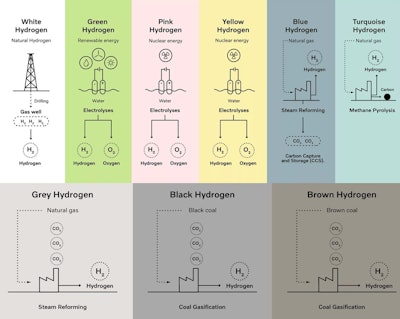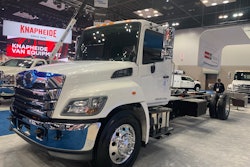The term green energy can take on a lot of interpretations. I suggest one realist’s definition is that green energy is any energy that groups can make money off of.
The number of energy avenues being funded by federal, state and local governments and other groups has mushroomed. Countries like France and Germany are debating whether or not hydrogen from nuclear energy can be considered green. Hydrogen made from natural gas can be considered green if it is combined with new technology for carbon capture and sequestration. Sequestration is a big word to mean storage. Concepts that re-use captured carbon such that their average net emissions are low enough can be considered green.
Congress and U.S. Department of Energy wrote a definition for greenness into the Inflation Reduction Act (IRA) that has a sliding scale of greenness based on lifecycle greenhouse gas emissions (GHG) rates per qualified clean hydrogen (QCH) as shown in this table:

The National Law Review summarized the definition of QCH as hydrogen that is “produced through a process that results in a lifecycle greenhouse gas emissions rate not greater than four kilograms of CO2e per kilogram of hydrogen.” Such hydrogen must be produced in the U.S. in the taxpayer’s ordinary course of trade for sale or use and must be verified by an unrelated third party.
So green hydrogen is not defined by how you make the energy, but by how much GHG in total the system produces in creating each kilogram of hydrogen. As a former systems engineer writing aerospace requirements documents, I embrace that the regulations are written around the “what” rather than the “how.” That is the goal of proper specification writing. You define what you want and then let the marketplace and the innovators figure out various “hows” of getting it done. Another term for greenness is “carbon intensity.”
However, the color of energy matters as well. I proposed an energy source color spectrum in the 2020 NACFE report Making Sense of Heavy-Duty Hydrogen Fuel Tractors. In working on a follow-up to that report to be released this spring, I came across Volvo’s great graphics on the topic, which I’ve summarized in this figure.

The IRA’s definition of greenness allows a range of fossil fuel and nuclear fuel-based solutions to be considered green if the analysis of the net life cycle GHG emissions is low enough.
"All energy is local"
It’s fine to say nuclear energy is green until perhaps you wind up with a nuclear powerplant in your back yard, or a nuclear waste storage facility. It’s fine to bet on carbon capture technology evolving to make natural gas production a minimal GHG producer, but do you really want to perpetuate the use of fossil fuels in your community?
Those are hard questions to ask and answer. There are a lot of factors that weigh into those questions. Opinions vary across the board depending on which vested interests you listen to. Aside from the obvious environmental ones, chief ramifications of energy choices are jobs and the potential economic impact to a region. Other critical factors relate to environmental justice.
Looking at arguments based on averages, the net effect over a region over a length of time is great for policy makers but really misses the point for each person directly impacted by the choices. None of us live in an average world, however simple that makes it for policy makers. The real world has a distribution of realities with respect to a multitude of factors. What makes sense in one location may make no sense in another.
Green may be a state of mind. Green today seems to mean you can get money for anything as long as you can sell the idea that your approach could get GHG emissions down.
Technology maturation is never assured. There is this nagging issue that it has to be profitable at some point and a second nagging issue is that the technology actually has to work in the real world. A lot of ideas generated at research facilities never make it to production success. Sometimes the potential is never realized, other times the critical supporting infrastructure and technology is not quite ready for prime time. In other cases, innovations bypass a technology and make it obsolete before it sees market success.
The world is tough on technologies. Modifying an Edison quote, innovation is 1% inspiration and 99% perspiration. Technologies also do not just mature in a vacuum. They are impacted by and sometimes need other technologies to mature in parallel. In the world of hydrogen, high pressure, cold, fast storage and delivery systems are needed. Inexpensive and long-lasting materials are needed in many parts of the new systems. Recycling methods need development. Maintenance and repair systems need development. It’s not just about how you produce the hydrogen.
Pick any of the new alternatives to traditional diesel and you can identify risks and challenges. There are no sure things. Throw in global geo-politics and economics and a world of unknowns are facing each technology.
NACFE discusses the interim future of commercial freight hauling as the messy middle — that period when multiple technologies are developing in parallel to improve over traditional diesel. And diesel is not out of that game either. One concept has carbon capture at the vehicle level and then the captured carbon is offloaded when delivering the freight for use in cement production, for example.
And isn’t there more to it than greenhouse gases? Of course, there is. GHG is just one of many metrics critical to defining success of energy technologies. We tend to live in a world that likes to simplify complex issues as if they are football games with one winner and one loser. If only the real world was that simple.
Where there is money there is opportunity, and innovators thrive in that environment. The green energy is truly the dollars being invested. I hope the majority of players chasing the dollars are sincerely interested in being successful rather than opportunistically gold digging, or playing defense. It is not overstating things to say the world is in the balance.














